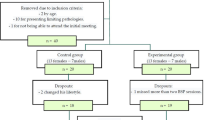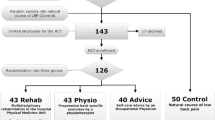Abstract
An educational program which emphasized the symmetrical use of back muscles was studied at a health care facility which had extremely high time lost injury rates due to back strains. Participants (N=180) were involved with half studying an educational program entitled “Back to Balance” with the remainder serving as controls. After 3 months, the controls studied the program. All subjects completed psychological tests, received cervical and lumbar paraspinal dynamic EMG evaluations four times (pre-and post-treatment, and after 3 and 12 months). Administrative indices (costs, incidence, and time lost injury rate) were obtained for the 3 years prior to the study and for the 1 year of the study. The 1-year results showed decreased pain, retained knowledge which was generalized to the home, and significantly improved symmetry of both sets of muscles. Administrative data revealed a 72% decrease in the time lost injury rate with reduced costs.
Similar content being viewed by others
References
Feuerstein M. A multidisciplinary approach to the prevention, evaluation, and management of work disability.J Occup Rehab 1991; 1: 5–12.
Fine J.Your guide to coping with back pain. Toronto: McClelland & Stewart, 1985.
Gibeau C.Review of work related back injuries Alberta 1974–1980. Alberta: Alberta Workers' Health Safety and Compensation, 1982.
Georg A, Stuppart R, Zoike E. Karankhiet und arbeirtsbedingte Belastung, Bund 1. Essen: Bundesverband der Betriebskrankenkassen, 1981.
Donaldson S.The Effect of Correcting Muscle Asymmetry upon Chronic Low Back Pain. Unpublished doctoral study, University of Calgary, 1989.
Donaldson S, Donaldson M. Multichannel EMG assessment and treatment techniques In Cram JR, ed,Clinical EMG for surface recordings (Vol. 2). Nevada City: Clinical Resources, 1990, pp. 143–173.
Melzack R. McGill Comprehensive Pain Questionnaire interviewer guide. In Melzack R, ed.Pain measurement and assessment, New York: Raven, 1983, pp. 10A-14A.
Derogatis LR.SCL-90-R Manual-1. Baltimore: Johns Hopkins University Press, 1977.
Dolce JJ, Raczynski JM. Neuromuscular activity and electromyography in painful backs: Psychological and biomechanical models in assessment and treatment.Psychol Bull 1985; 97: 502–520.
Wolf SL, Basmajian JV. Assessment of paraspinal electromyographic activity in normal subjects and in chronic back pain patients using a muscle biofeedback device. In Asmussen E, Jorgensen K, eds,Int Ser Biomech 1978; VIB: 319–324.
Triano JJ, Schulz AB. Correlation of objective measure of trunk motion and muscle function with low back disability ratings.Spine 1987; 12: 561–565.
Author information
Authors and Affiliations
Rights and permissions
About this article
Cite this article
Stuart Donaldson, C., Stanger, L.M., Donaldson, M.W. et al. A randomized crossover investigation of a back pain and disability prevention program: Possible mechanisms of change. J Occup Rehab 3, 83–94 (1993). https://doi.org/10.1007/BF01078161
Issue Date:
DOI: https://doi.org/10.1007/BF01078161




